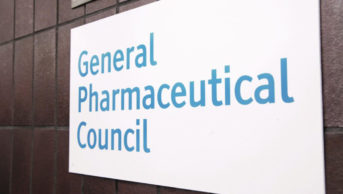
Courtesy, GPhC
The British pharmacy regulator has stressed that pharmacy owners must continue to ensure they have enough qualified staff to provide safe services, despite funding cuts that are due to be implemented from 1 December 2016.
The General Pharmaceutical Council (GPhC) says pharmacy owners must make sure that governance arrangements safeguard the well-being of patients and that the safety and quality of pharmacy services are kept under review.
Speaking at a GPhC seminar on ‘Professionalism under pressure’ held in London on 18 October 2016, GPhC chief executive Duncan Rudkin said: “It is not for the regulator to set staffing levels; pharmacy owners must consider how many staff are needed within each individual pharmacy… and how they are deployed and managed to provide services safely and effectively.”
The seminar was announced in June 2016 after a Guardian investigation highlighted the issue of target setting for NHS-funded services within Boots pharmacies. The GPhC decided not to investigate Boots over the allegations that it placed unacceptable pressure on pharmacists to perform medicines use reviews (MURs), a service introduced in 2005 to help patients use their medicines optimally.
“We will continue to probe in this area, so pharmacy owners, superintendent pharmacists and responsible pharmacists should be ready to demonstrate how they are upholding the relevant standards to safeguard the health, safety and well-being of patients and the public,” Rudkin told delegates at the seminar, adding that pharmacy owners must ensure that staff are “empowered to provide feedback and raise concerns” about meeting the GPhC’s pharmacy standards.
Unlike other professional regulators, the GPhC regulates large corporations as owners of pharmacies, as well as individual healthcare professionals.
In an interview with The Pharmaceutical Journal at the seminar, Rudkin was asked if the GPhC had the confidence to regulate large companies and to tackle issues such as target setting for pharmacy staff.
Rudkin said: “We have standards that we set which the owners of those pharmacies must meet.
“[The standards] are focusing on outcomes because we recognise that the context of a pharmacy that is owned by an individual pharmacist is going to be very different from the context of a pharmacy that is owned by a large chain or may be located within a supermarket.”
Asked how the GPhC will respond if it starts seeing more fitness-to-practise cases as a result of the funding cuts, Rudkin said: “We are independent of the government, just as we are independent of pharmacy owners and pharmacy professionals. It is essential there is a regulator that stands to one side of all of that activity, all of those pressures, [and] is able to comment on those, to highlight issues and to bear them in mind as we continue our work.”
Sandra Gidley, chair of the English Pharmacy Board at the Royal Pharmaceutical Society, who attended the GPhC seminar, said afterwards that it was “a useful start but is a work still in progress”.
“[Common themes that emerged] included a huge kick back against a target-ridden culture which was not related to improving patient outcomes and a greater need for people to be able to speak up without fearing recriminations. It is also clear that other health professions share our concerns,” she added.
Gidley said she looked forward to seeing how the GPhC will “work these ideas up into something which not only reminds employers of their responsibilities but also empowers individual pharmacists to always do what is in the best interest of the patient.”
John Murphy, general secretary of the Pharmacists’ Defence Association (PDAU), a union for pharmacists, told The Pharmaceutical Journal that it “welcomes the warnings given to owners and superintendents by the GPhC and [it] will support responsible pharmacists in making rational decisions about the safety of the pharmacy”.
He added: “We expect the GPhC to act if there are recriminations against the responsible pharmacist by their employers should they deem the pharmacy unsafe to continue to operate.”
However, the PDAU has reservations about whether the GPhC inspection model is ‘fit for purpose’.
“Earlier this year, the PDA patient safety survey, the Guardian article ‘How Boots went rogue’ and the subsequent press coverage highlighted the problem of workplace pressure, poor staffing levels and commercial incentives and targets compromising public safety and professional judgement at Boots,” Murphy said.
“In its response to the article, Boots said it had received 1,135 GPhC inspection reports and only one pharmacy was identified as having problems with incentives and targets. We have written to the GPhC and asked them specifically: ‘Is the inspection model robust enough to identify the widespread workplace issues that have been reported in the press and have the potential to adversely impact upon patient safety?’”
A week before the GPhC seminar (on 10 October 2016), the PDAU made available a short report summarising research by the Kent University Business School that was based on surveys conducted in 2010 looking into pressure put on pharmacists by employers to meet MUR targets.
“The analysis concluded that bullying tactics to achieve MURs are at best tolerated by employing organisations and at worst are being routinely used to push pharmacists to achieve MUR targets,” the PDAU said in a statement on its website on 10 October 2016.
“The results portray non-supportive environments and adverse working conditions. These are not conducive to pharmacists autonomously utilising their unique professional skills to optimise medicines use for patients, via the undertaking of MURs.”
He added: “Six years later and we’re still experiencing the same issues.”
You may also be interested in

Pharmacy regulator considers giving up legal authority to conduct covert investigations of pharmacists

Pharmacy regulator to increase registration fees by 7.5% from April 2024
